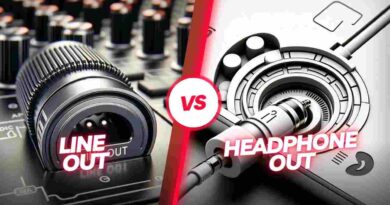Preamplifier Vs. Amplifier: What’s The Difference?
When setting up an audio system, whether it be for home audio, a professional studio, or a live performance setup, understanding the difference between a preamplifier and an amplifier is crucial. These components are fundamental to managing your sound quality and dynamics, but they serve very distinct purposes. In this blog post, I’ll explain what makes a preamplifier different from an amplifier, detail their functionalities, and help you decide which one you might need—or whether you need both.
What is a Preamplifier?
A preamplifier, often referred to as a “preamp,” is a device that amplifies the low-level output from your source equipment to a level that an amplifier can effectively work with. Let’s break down its role and importance:
- Role in Audio Systems: The preamplifier takes the weak electrical signals from sources such as microphones, turntables, and instruments, and amplifies them to line level. This is the standard signal strength used in audio processing equipment.
- Functionality: Besides amplification, preamps allow you to control volume, balance, and tone. They can also switch between audio sources without the need to adjust the volume continuously.
- Technical Specifications: Preamplifiers handle very low voltages, often in the range of millivolts. For instance, a microphone’s output can be as low as 2 millivolts, which the preamp boosts to about 1 to 2 volts (line level).
Key Takeaways:
- Preamplifiers boost weak signals to line levels.
They include controls for sound customization.
What is an Amplifier?
An amplifier, on the other hand, takes the line-level audio signal from the preamplifier and boosts it to a level where it can power speakers. Here’s more on what an amplifier does in your audio setup:
- Role in Audio Systems: Amplifiers are the muscle of the audio system. They provide the necessary power to drive your speakers, turning the preamplified signals into sound that can fill a room.
- Functionality: Amplifiers significantly increase the amplitude of the audio signals, enabling them to drive the large drivers in loudspeakers without distortion that can occur from under-powering.
- Technical Specifications: Amplifiers deal with higher voltages, typically around 20 to 30 volts for consumer audio and much higher for professional audio systems.
Key Takeaways:
- Amplifiers increase the signal strength to drive speakers.
- They ensure sound is delivered at sufficient power to avoid distortion.
Differences Between Preamplifiers and Amplifiers
Understanding the distinctions between these two types of audio equipment is key to optimizing your audio system’s performance:
Signal Strength Handling
- Preamplifier: Deals primarily with very low signal levels, amplifying them just enough to be processed by an amplifier without adding noise or distortion.
- Amplifier: Works with already boosted signals, increasing their power to a level sufficient to drive speakers.
Functionality and Control
- Preamplifier: Provides user control over the audio signal, including volume adjustments, equalization, and source switching, which are crucial for fine-tuning the audio output.
- Amplifier: Focuses on power delivery and generally does not offer user control over the sound characteristics.
Use Case
- Preamplifier: Essential for setups where multiple audio sources need to be managed and adjusted before amplification.
- Amplifier: Required whenever speakers are used, to ensure they receive enough power.
Importance of Preamplifiers in Audio Quality
Preamplifiers play a critical role in defining the quality of your audio output:
- Noise and Distortion: A good preamplifier minimizes noise and distortion, which can be crucial when dealing with delicate audio signals like those from a vinyl turntable or a studio microphone.
- Versatility and Control: By allowing you to adjust the tone and balance of your audio, preamplifiers contribute to a more tailored listening experience.
- Enhancing Dynamics: Preamplifiers help in enhancing the dynamics of audio by ensuring that the signal is clean and strong enough for further amplification.
Role of Amplifiers in Sound Production
Amplifiers are indispensable for their role in sound production:
- Driving Speakers: Without an amplifier, even the best speakers can’t produce sound from the low-level audio signals they might receive.
- Maintaining Sound Integrity: Amplifiers must amplify sound without altering its integrity, which requires precision engineering.
- Handling Power: Good amplifiers not only boost volume but also manage power distribution to speakers to prevent damage and optimize performance.
When Do You Need a Preamplifier?
Identifying when you need a preamplifier depends on your setup and requirements:
- Multiple Audio Sources: If your setup includes multiple low-level input sources, a preamplifier is necessary to manage and prepare these signals for amplification.
- Sound Quality Enhancement: For audiophiles and those in the recording industry, a preamplifier is crucial for achieving high-quality sound output without noise and distortion.
- Detailed Sound Control: If you need fine control over balance, tone, and volume, a preamplifier is essential.
When Do You Need an Amplifier?
An amplifier is required in nearly all audio setups, but specifically:
- Speaker Operation: Any audio system that involves speakers will require an amplifier to drive those speakers.
- High Volume Needs: Settings that require sound to fill large spaces, like concert halls or large outdoor areas, will especially benefit from powerful amplifiers.
- Enhanced Audio Performance: In home theaters and similar setups, an amplifier is necessary to achieve cinema-like sound quality.
Comparing Preamplifier and Amplifier Specifications
When comparing preamplifiers and amplifiers, consider their specifications:
- Input Sensitivity and Gain: Preamplifiers must have high input sensitivity to pick up low-level signals, whereas amplifiers have high gain to boost these signals to high levels.
- Signal-to-Noise Ratio (SNR): Both devices should have a high SNR to minimize noise in the audio output, but it’s especially critical for preamplifiers since noise at this stage can be amplified later.
- Power Handling: Amplifiers need to handle significant power levels to drive speakers, unlike preamplifiers which deal with smaller signals.
Conclusion
Choosing between a preamplifier and an amplifier isn’t about which is better but rather about understanding their roles in your audio setup. For most systems, you actually need both: a preamplifier to prepare and enhance the audio signals and an amplifier to drive the speakers effectively. Each component is crucial for delivering high-quality audio tailored to your environment and listening preferences.
Frequently Asked Questions
Do I need both a preamplifier and an amplifier?
Yes, in most cases, both a preamplifier and an amplifier are necessary for a complete audio system.
Can a preamplifier work alone?
A preamplifier cannot drive speakers alone; it must be paired with an amplifier.
What should I look for in a good preamplifier?
Look for high input sensitivity, low noise levels, and user-friendly controls for sound customization in a good preamplifier.
What makes a good amplifier?
A good amplifier should have high gain, excellent power handling, and maintain sound integrity at high volumes.
Is an amplifier necessary for low-volume listening?
An amplifier is still necessary for low-volume listening as it powers the speakers, regardless of the volume level.
Can I use an amplifier without a preamplifier?
Using an amplifier without a preamplifier is possible if your audio source provides sufficient line-level signal, but for optimal sound quality and control, a preamplifier is recommended.
How do preamplifiers enhance audio quality?
Preamplifiers enhance audio quality by boosting low-level signals and allowing for detailed adjustments before amplification.
Why is an amplifier important in a home theater?
In a home theater, an amplifier is important to drive multiple speakers with enough power to produce cinema-like sound.
Can I skip using a preamplifier in a professional setting?
In a professional setting, skipping a preamplifier is not advisable as it provides the necessary signal conditioning before amplification.
What are the signs of needing an amplifier upgrade?
Signs of needing an amplifier upgrade include inability to reach desired volume levels, noticeable distortion at high volumes, and lack of clarity in sound.




